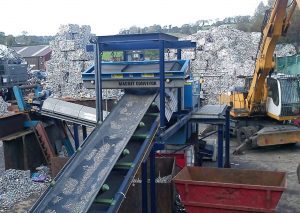Three Things to Consider when Installing Crossbelt Magnets

Permanent crossbelt magnets are some of the most popular and most commonly used varieties of magnetic separators. Crossbelt magnets are frequently found in recycling plants as well as quarries and mobile plants within the aggregate, mining, and mineral industries. In the aggregate, mining, and mineral industries, crossbelt magnets work to protect screens and crushers from the damage that can be caused by ferrous metals.
A crossbelt magnet has a simple design that features two pulleys mounted on a frame on either side of a permanent magnetic block. Crossbelts are designed to facilitate easy installation, and may be mounted over a conveyor’s head pulley or, most commonly, across the conveyor belt.
In order for a crossbelt to perform most effectively, it must be correctly installed. After initial installation has been completed, it is important to make sure that positioning does not change, as this can hamper separation performance in the future. In this blog, we will discuss three important installation factors to consider when optimizing placement of a crossbelt magnet.
1. Suspension Height
Each crossbelt is designed to operate at a specific height above a conveyor. Sometimes, the crossbelt magnet may be temporarily raised in order to accommodate an occasional surge of material. When the distance between the conveyor belt and crossbelt magnet increases, the magnetic field is positioned at a greater distance from the conveyor belt. This can lead to reduced magnetic separation performance.
Every time a crossbelt is temporarily raised, it must be returned to its original height position. Otherwise, ongoing metal separation performance is likely to suffer. If frequently lowering and raising a crossbelt magnet is inconvenient or otherwise not practical for an application, it is recommended that plant owners consider installing a larger crossbelt magnet. Bunting offers larger crossbelt magnets designed to consistently produce a deeper magnetic field, allowing for superior magnetic separation even when the magnet is suspended at a greater height above the conveyor.

2. Magnet Width vs. Conveyor Width
Each crossbelt magnet is designed with a magnet block in a specific size. When Bunting is evaluating an application, both the width of the conveyor and the ferrous metal discharge point are taken into consideration. If a crossbelt’s magnet block is not wide enough, ferrous metal can be lifted out of conveyed material only to be discharged back onto the conveyor. Usually, problems with a magnet block’s width occur when a crossbelt is moved from its original location to a new location. The new location may have a discharge point that is further away or may simply have a wider conveyor belt.
3. Positioning Crossbelt Magnets Over the Conveyor
Most crossbelt magnets are designed with a magnet block that has one centrally located single pole, which then projects a magnetic field down towards the conveyor. As a result, the center of the magnet block line is where the maximum level of attraction and separation occurs. Often—especially when a crossbelt magnet is too narrow for the conveyor belt it is installed above—the center line is positioned to one side of the conveyor, usually closer to the discharge area. This is a problem as the magnetic field on the opposite side of the conveyor becomes significantly lower. As a result, the likelihood of ferrous metal on this opposite side being separated effectively is reduced.
Conclusion
As is the case with most processing equipment, optimum performance is highly dependent on correct positioning. By making simple, easy adjustments to a crossbelt’s suspension height and position, ferrous metal recovery rates can be significantly improved. To learn more about crossbelt magnets and our other magnetic separation equipment, Contact us Today.



